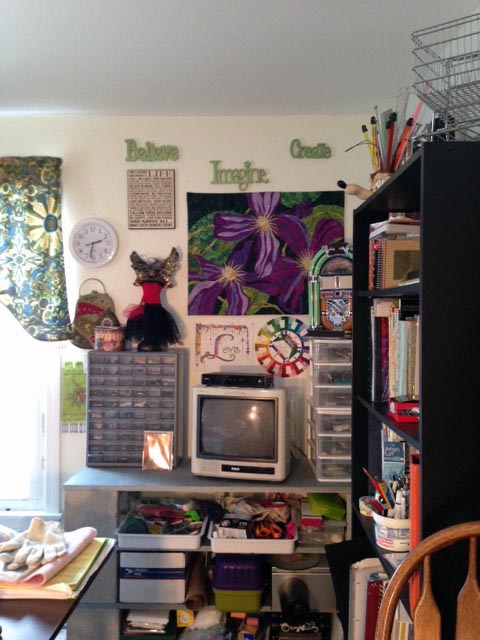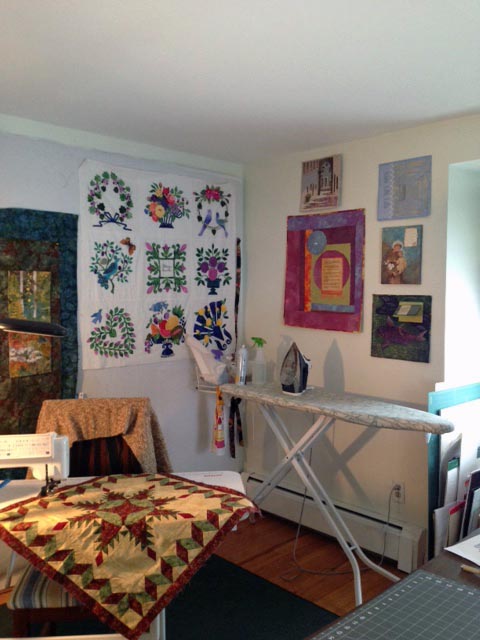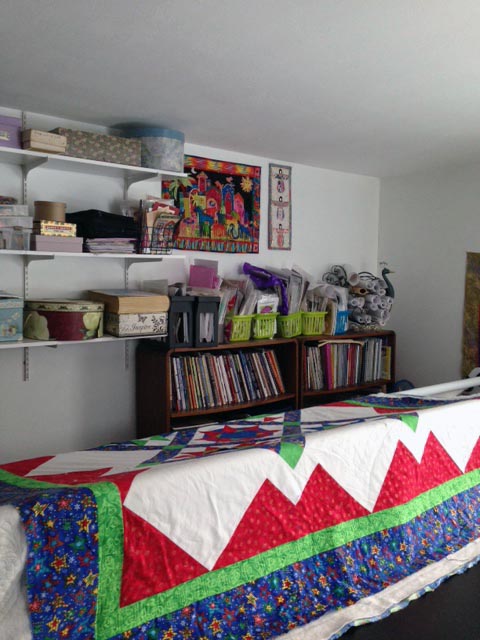This month we are visiting with Laurie Dhandapani in Vernon, Connecticut.
Do you call it a studio or sewing room? To yourself, to friends and family? Why do you think this is so? Difference in starting point between quilting and art? Thinking of this as a business rather than a hobby?
I play in many different mediums, so I consider myself a mixed media artist: but I am also a professional quilter and teacher. Since sewing is only a part of what I do, I refer to my work areas as a studio. I also think it makes me take my art more seriously.
What do you have in the room? machines, supplies, fabrics, paints, etc. Anything that might surprise the rest of us?
I have all the ‘usual’ quilting supplies, rulers, cutting implements, fabric and a sewing machine; but because I like to paint (both on fabric and other surfaces) I have a wide assortment of paints, dyes, inks, markers and pens. I also like to do surface design, so I also have some odd things on the shelf like, rice cereal and boxed mashed potatoes (These make great resists on fabric.)
I have a good assortment of stamps and stencils. I have a lightbox, stencil cutter and a heat tool for distressing/distorting things. The best thing I did was put up a 6 foot by 8 foot design wall. Not only can I put things up as I work, but I often hang a project that is ‘stuck’ and after looking at it for a while, the solution comes to me.
I love to draw and journal, so I also have lots of paper. I have a longarm machine as well, both for myself and customer quilts.
How is your “stuff” organized? How do you organize your fabric? By color? Amount? Any separate categories (batiks, hand dyes)? How do you organize your thread (color, weight)?
I try to organize my supplies by medium. One closet holds paints/ dyes and another closet for batting.
Thread is organized by type- the frequent flyers are on a stand and the others are kept in plastic boxes. Generally the things I use frequently are on open shelves or on a pegboard so I can readily get to them.
And then there is the fabric. I am a self- proclaimed “collector” of fabric! I gravitate toward batiks and ethnic fabrics, but also have some silk and velvet. I have acquired lots of fabric and know that it will eventually find a way into something I am making. I also collect ribbons, lace, buttons and ephemera, for embellishing.
Do you have anything, supplies, more machines, etc. tucked away in any other rooms of the house. How many other rooms? (My husband likes to talk about that one.) Has a family member or significant other ever accused you of “taking over” the entire house? If you have a separate building, we want lots of pictures.
I manage to contain my ‘stuff’ to two bedrooms…although I did need to convince a couple of kids to move out! One room houses the longarm machine, the equipment pegboard and most of my fabric and the other room is really my working studio.
How much horizontal surface do you have, and is it ever enough? Do you have to move piles of stuff to cut anything bigger than a fat quarter?
Do you straighten/organize as you go, putting each fabric away as you cut, or do you clean up after a project? How many projects do you work on at a time and how do you keep them organized?
My working table is a six foot banquet table on supports to raise it up, so I can stand to work. I do all of my cutting and non-sewing work on this table. My sewing machine is in its own table. In a pinch I work on the ironing board. I try to keep the cutting table cleared off as much as possible. I tend to work on several projects at a time. I keep each one in a basket or bag so I can easily pick up and begin work.
Anything more you want to add about your studio, organization, working methods, etc., please do.
Making art is personally fulfilling. As a teacher I am thrilled when a student ‘gets it’ and I enjoy quilting for someone to complete their vision. I love what I do!
Thank you, Laurie, for letting us tour your studio.
Next Month: Colette Herrin






